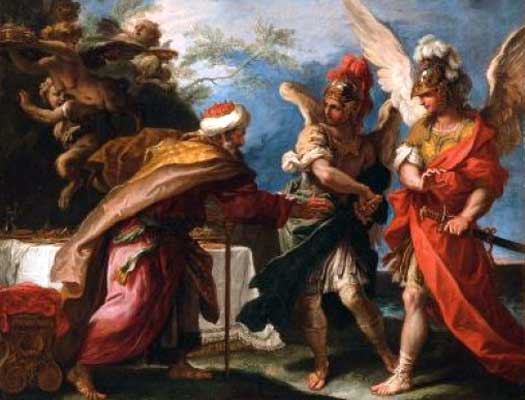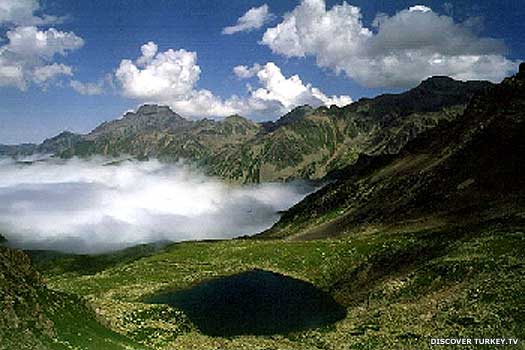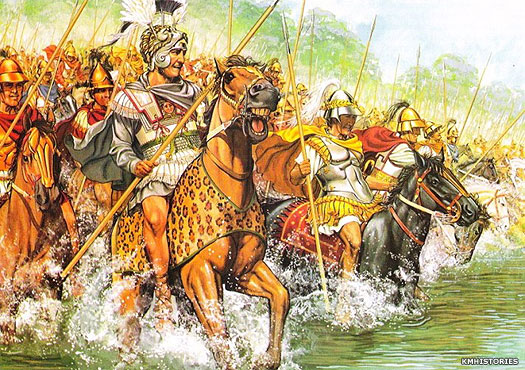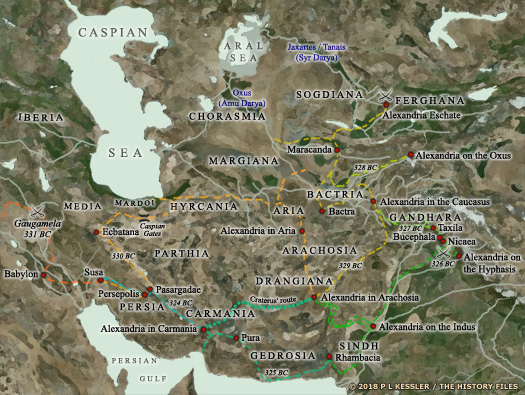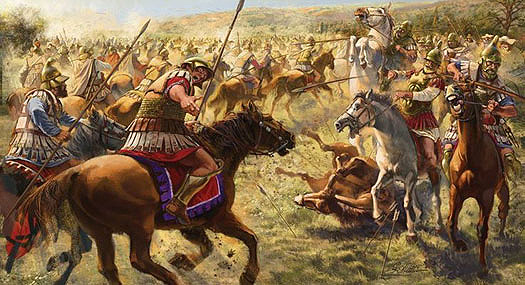
| PAPHLAGONIA This was an ancient region on the Black Sea coast in northern Anatolia. It was relatively unimportant in its level of participation in historical events. Much of the country is rugged and mountainous, with occasional fertile valley regions, and its inhabitants were often regarded as ungovernable barbarians. Strabo mentioned that the region's western limits were formed by the River Parthenius (the modern Bartin, with its source in the Ilgaz Mountains), whilst an eastern border was supplied by the River Halys (the modern Kizilirmak, which the Hittites called the Maraššantiya).
Paphlagonia emerged at the end of the second millennium BC during the Bronze Age collapse, with Luwian-speaking Indo-Europeans apparently migrating into what had recently been Kaskan territory. The Kaskans themselves were non-Indo-Europeans who had seemingly only recently migrated into the region to take over territory around the indigenous city of Zalpa, and it seems that they may have been bumped further eastwards by the arrival of the Luwian speakers. The Luwians came from the south, from neighbouring Tabal (later known as Cappadocia) as part of a general colonisation of southern Anatolia and expansion northwards.
In Classical times Paphlagonia was located between Bithynia to the west and Pontus to the east. Phrygia lay to the south-west but was separated from it by a mountain range called the Bithynian Olympus. Homer sets out a basic framework for Paphlagonia's initial settlement by Trojans, and Strabo makes it clear that nothing has changed in the meantime, including the names and the people. Its largely independent princes seemingly termed themselves pylaimenes as a symbol of their claimed descent from Pylaemenes of the Eneti, supposedly the chief of the Paphlagonians during the early twelfth century BC (and who is mentioned in the Iliad). Towards the end of the Classical period Phrygia was invaded and taken over by Celts who founded a kingdom that became known as Galatia. However, the kingdom only partially infiltrated into Paphlagonia.
(Additional information from A Geographical and Historical Description of Asia Minor, John Anthony Cramer, from The Iliad, Homer (Translated by E V Rieu, Penguin Books, 1963), and from External Link: Encyclopaedia Britannia, 11th Edition.)
c.1500 BC :
According to Greek legend, Phineas is the son of Agenor, king of Tyre. He and his four brothers, Cadmus, Cilix, Phoenix, and Thasus have all departed their Phoenician home in search of their sister, Europa, who had been abducted by Zeus. Phineas gives up his search in eastern Thrace, where he settles on the western shores of the Black Sea and rules a city state of his own.
There are two kings of early Thrace named Phineas, the first of whom was a Phoenician while the second was rescued by Jason from harpies, and it is the latter who is shown here Phineas becomes the father to Bithynus, Mariandynus, Paphlagonus, and Thynus (Bithynus and Thynus are adopted from one Odrysus, the eponymous namesake of the later Thracian kingdom). The four each found kingdoms along the shores of the Black Sea; Bithynia, Mariandyne, Paphlagonia, and Thynia.
fl c.1480 BC :
Paphlagonus : Son of Phineas of Thrace.
c.1180s BC :
Pylaemenes of the Eneti : The Eneti (Heneti) was a Thracian tribe. Killed at Troy.
c.1180s BC :
Harpalion of the Eneti : Son. Killed at Troy.
c.1193 - 1183 BC :
Pylaemenes of the shaggy breast leads the Paphlagonian force to the Trojan War on the side of Troy, which includes his son Harpalion, and contingents from Aegialus, Cromna, Cytorus, Erythini, Sesamus, and from along the River Parthenius.
Antenor, ally of Aeneas of the Dardanians, sails into the furthest part of the Adriatic (the northern reaches), accompanied by a number of Enetians who have been driven from Paphlagonia by revolution following the death of their king, Pylaemenes, before the gates of Troy. They defeat the north Italian Euganei and occupy their lands near the coast, later to be known as the Veneti tribe.
A contingent of Halizones which also fights for Troy could be from Paphlagonia. Homer calls Odius the chief of the Paphlagonians, placing them in north-eastern Anatolia. It seems likely that the Halizones move into the region at the same time that Paphlagonia begins to emerge, displacing or subsuming Kaskans here until the latter finally vanish from the historical records in the eighth century BC.
c.1180s BC :
Odius : Son of Mecisteus of the Halizones. Chief of the Paphlagonians?
c.630 BC :
Greek settlers from Miletus in Caria refound the town of Sinope in Paphlagonia. The city seems previously to have been a Hittite port named Sinuwa until the dark age collapse of that state. The city becomes an important link in a regional trade route and in time founds its own colonies.
c.585 BC :
Alyattes of II Lydia loses the Battle of the Eclipse to Media in a fifteen year war which is otherwise relatively evenly matched. Lydia expands in his reign to form an empire that covers all of western Anatolia and includes Paphlagonia. The end of the war signals the start of closer ties between the two kingdoms. Alyattes gives his daughter in marriage to Astyages, son of Cyaxares.
549 - 546 BC :
The Persian defeat of the Medes opens the floodgates for Cyrus with a wave of conquests, beginning with Cilicia in 549 BC. Harpagus, a Median of the royal house and the main cause of the defeat of the Medes, commands Cyrus' army in Anatolia, conquering it between 547-546 BC. Taken during this campaign are Caria, Lycia, Lydia, Paphlagonia, Phrygia, and Tabal (Cappadocia). Harpagus and his descendants reign thereafter in KarkÔ (Caria) and Lykia (Lycia) as satraps of the empire, normally within the satrapy of KarkÔ. Paphlagonia appears to be granted special status, perhaps due to the ungovernable nature of the land. The natives retain their own princes who rule independently of neighbouring satraps.
Persian Satraps of Paphlagonia :
The attempt in 549 BC by the kingdom of Lydia to invade Anatolian lands which now belonged to the Persian empire saw an appropriate Persian response. Cyrus the Great invaded Lydia and crushed it, and then proceeded to capture the rest of Anatolia too. The kingdom of Phrygia and the minor city states of KarkÔ also fell between 549-546 BC. Following that, a Persian layer of administration was introduced to replace the lost kingships. However, direct control may only have been nominal. Later events suggest that the Paphlagonians were not especially controlled by anyone other than themselves.
To the west, Paphlagonia bordered the satrapy of Hellespontine Phrygia. To the north it reached the sea, and in the east the minor satrapy of Katputka (Cappadocia). The southern border is somewhat less clear, but the writer Curtius Rufus reported that Paphlagonia was entered near Ancyra, so the border may have followed the modern Ankara Suyu, a tributary of the ancient Sangarius (Sakarya).
The satraps perpetuated the illusion of ruling the region in the name of the Persian king until invasion and conquest by Alexander the Great gave them the chance of going it alone - now in name as well as in probable fact. Occasionally local leaders would be able to form a unified tribal kingdom, but rarely one that endured. Typically, details of the satraps themselves in the fifth century are extremely scarce, and even immediately preceding the Greek invasion little is really known of them. If the Persians recorded the names and dates of office of their various satraps, these details rarely survived.
(Information by Peter Kessler, with additional information from The Histories, Herodotus (Penguin, 1996), from The Persian Empire, J M Cook (1983), from Alexander the Great, Krzysztof Nawotka (Cambridge Scholars Publishing, 2009), from A Political History of the Achaemenid Empire, M A Dandamaev, and from External Links: Encyclopaedia Iranica, and Lives of Eminent Commanders, Cornelius Nepos (1886 Edition).)
549 - 546 BC :
The defeat of the Medes opens the floodgates for Cyrus the Great with a wave of conquests, beginning with Cilicia in 549 BC. Harpagus, a Median of the royal house and the main cause of the Median defeat, commands Cyrus' army in Anatolia, conquering it between 547-546 BC. Taken during this campaign are Armenia, Caria, Lycia, Lydia, Paphlagonia, Phrygia, and Tabal (Cappadocia), and Harpagus and his descendants reign thereafter in KarkÔ (Caria) and Lykia (Lycia), and apparently Cilicia too, as satraps.
Cyrus the Great freed the Indo-Iranian Parsua people from Median domination to establish a nation that is recognisable to this day, and an empire that provided the basis for the vast territories that were later ruled by Alexander the Great While the other conquered regions in Anatolia gain major or minor satrapies or, in a few cases, retain local leaders as vassals, how Paphlagonia is governed remains a mystery. Local princes are known to rule on at least a semi-independent basis during the mid-fifth century BC, so it is likely they do so from the start, with the blessing of their new overlord, Cyrus, who tacitly understands that bringing these strong-willed mountain folk under full control is probably more trouble than it is worth. Instead it is likely that the satrap of Katputka or Phrygia is tasked with keeping an eye on things here.
546 - ? BC :
? : Satrap or native vassal ruler unknown.
480 - 479 BC :
Paphlagonia with its still-independent but generally unrecorded princes contributes an important, numerous contingent to the Persian army of Xerxes which invades Greece. Once there the Persians subdue the Thracian tribes, and they join his forces too, all except the Satrai, precursors to the Bessoi, who refuse to succumb. The Macedonians are also subdued but continue to supply aid in the war against the Persians. Then the vast army of the Persian King Xerxes makes its way southwards and is swiftly engaged by Athens and Sparta in the Vale of Tempe. The Persians are subsequently stymied by a mixed force of Greeks led by Sparta at Thermopylae. (These events are depicted somewhat colourfully - but no less impressively for that - in the 2007 film, 300.)
Athens, as the leader of the coalition of city states known as the Delian League, then defeats the Persian navy at Salamis, and after Xerxes returns home his army is decisively defeated at the Battle of Plataea and kicked out of Greece. (The naval battles of Artemisium and Salamis are shown to superb graphic effect in the 2014 sequel film, 300: Rise of an Empire, although it does contain a great many historical inaccuracies.)
c.425 BC :
By this time a dynasty of native satraps have emerged into history, governing the region (probably on the usual semi-independent basis) for the Achaemenid Persians. They are reputedly descended from Pylaemenes of the Eneti, a twelfth century BC Thracian in Paphlagonia who had been killed at Troy.
Like the Kaskans before them, the Paphlagonians struggled to survive in the somewhat tough conditions of the Black Sea's southern coast c.425 - 400 BC :
Corylas : Prince, or Achaemenid satrap of Paphlagonia?
c.400 - 380 BC :
Cotys : Son or brother. Achaemenid satrap of Paphlagonia?
c.380 - 364 BC :
Thuys / Thyus : Son or brother. Achaemenid satrap of Paphlagonia?
364 BC :
This is the point at which the native princes of Paphlagonia are finally removed from holding any kind of office. They are replaced by various individuals from more powerful regions. By now the Greek city of Sinope has also fallen under Persian domination.
Datames, satrap of Khilakku (which includes Katpatuka and Paphlagonia) is the first outsider to take control. He seizes Paphlagonia upon the orders of Autophradates, satrap of Sparda. Cornelius Nepos writes that Thyus, 'prince of Paphlagonia, a man of ancient family', descended from the twelfth century Pylaemenes (see above), is taken prisoner by Datames. He also states that Datames and Thyus are first cousins, so it is apparent that the vassal Persian satraps are likely taken from compliant members of the local nobility.
Given the fact that he has made enemies within the regional Persian administration through his successes and his promotion to govern the minor satrapy of Cappadocia-beside-the-Pontus, Datames seized Paphlagonia as his own and effectively declares that he is in revolt against Persia.
364 - 362 BC :
Datames : Of Katpatuka. Achaemenid satrap of Khilakku (inc Paphlagonia).
364 - 358 BC :
Soon all of Asia Minor (Anatolia) revolts against Persian King Artaxerxes II and, in 362 BC, even Autophradates, satrap of Sparda, is driven to join the rebels. Sparta, and also Takh˘s, pharaoh of Egypt, send substantial help to the rebels. Two years later, in 360 BC, Ariobarzanes is betrayed by his son, Mithridates, and is executed. The satrapal revolt is finally suppressed in 359-358 BC, by which time a replacement satrap seems to have been appointed in Paphlagonia, while Datames' son, Ariaramnes, is satrap of Katpatuka.
362 - 353 BC :
Sysinas : Achaemenid satrap of Paphlagonia. Also in Khilakku?
353 - 334 BC :
Arsites : Achaemenid satrap of Paphlagonia. Also in Phrygia. Suicide.
334 - 323 BC :
Alexander the Great launches his campaign into the Persian empire by crossing the Dardanelles. The first battle is fought on the River Graneikos (Granicus), eighty kilometres (fifty miles) to the east. The Persian defeat forces Arsites to commit suicide while the region is incorporated into Alexander's growing Greek empire. Sparda surrenders but KarkÔ's satrap holds out in the fortress of Halicarnassus with the Persian General Memnon.
Alexander the Great crossed the River Graneikos (or Granicus) in 334 BC to spark a direct face-off with the Persians that had been brewing for generations, and his victory in battle near the river sent shockwaves through the Persian empire Greek satraps hold nominal command, but often from beyond the mountain range that isolates Paphlagonia. In fact the mountain dwellers appear to provide as much trouble as ever to the Greek region of Paphlagonia.
Argead Dynasty in Paphlagonia :
The Argead were the ruling family and founders of Macedonia who reached their greatest extent under Alexander the Great and his two successors before the kingdom broke up into several Hellenic sections. Following Alexander's conquest of the Persian holdings in Anatolia and Syria between 334-331 BC, the Greek empire ruled the region until Alexander's death in 323 BC and the subsequent regency period which ended in 310 BC. Alexander's successors held no real power, being mere figureheads for the generals who really held control of Alexander's empire. Following that latter period and during the course of several wars, Anatolia was divided between Cassander of Macedonia, the Lysimachian empire, and the Antigonid empire.
The Persian satraps had perpetuated the illusion of ruling Paphlagonia in the name of the king until invasion and conquest by Alexander the Great gave the natives the chance of going it alone. However, direct control by the Persians may only have been nominal. Events during the lifetime of the empire events suggest that the Paphlagonians were not especially controlled by anyone other than themselves. Occasionally local leaders would be able to form a unified tribal kingdom, but rarely one that endured. Alexander was content to accept nominal submission from them without tribute being exacted.
Upon Alexander's death his two successors were retained as figureheads while the empire was governed by his powerful generals. Perdiccas, the leading cavalry commander, was the first general to rule, carrying the title 'Regent of Macedonia', initially with Meleager, head of the infantry officers, as his lieutenant, but alone after he had him murdered. Control of the empire was divided up, with Alexander's secretary, Eumenes of Cardia, gaining Cappadocia, Mysia, and Paphlagonia until he was also killed during the four Wars of the Diadochi.
(Information by Peter Kessler, with additional information from Dictionary of Greek and Roman Biography and Mythology, William Smith (Ed, 1867), from The Persian Empire, J M Cook (1983), from The Histories, Herodotus (Penguin, 1996), from Anabasis Alexandri, Arrian of Nicomedia, from Panyassis of Halikarnassos: Text and Commentary, PanÝasis, from The Generalship of Alexander the Great, J F C Fuller, from the Historical Dictionary of Ancient Greek Warfare, J Woronoff & I Spence, and from External Links: Encyclopaedia Iranica, and The Geography of Strabo (Loeb Classical Library Edition, 1932).)
334 - 323 BC :
Alexander III the Great : King of Macedonia. Conquered Persia.
323 - 317 BC :
Philip III Arrhidaeus : Feeble-minded half-brother of Alexander the Great.
317 - 310 BC :
Alexander IV of Macedonia : Infant son of Alexander the Great and Roxana.
334 - 325 BC :
Calas : Son of Harpalus of Elimiotis. Satrap of Paphlagonia & Phrygia.
325 - 323 BC :
Demarchus : Greek satrap of Paphlagonia.
323 BC :
Following the death of Alexander the Great, his former secretary, Eumenes of Cardia, commands Cappadocia, Mysia, and Paphlagonia. He is confirmed in 322 BC by the Greek regent, Perdiccas. The regent underlines his choice of ruler by defeating the deposed Ariarathes of Cappadocia, and then having him and many of his relations crucified. Eumenes soon finds his rule opposed by Nikanor, a Macedonian officer who serves first Cassander, would-be regent and king of Greece, and then Antigonus.
Diogenes of Sinope was the rather eccentric father of the Greek cynicism school of philosophy, living between either 412 or 404 BC and 323 BC, while above is the route of Alexander's ongoing campaigns, leading him from Europe to Egypt, into Persia, and across the vastness of eastern Iran as far as the Pamir mountain range 323 - 316 BC :
Eumenes of Cardia : Greek satrap of Cappadocia, Mysia, & Paphlagonia.
319/306 - 301 BC :
The death of Antipater of Greece leads to the Second War of the Diadochi. He had passed over his son, Cassander, in favour of Polyperchon as his successor (possibly to avoid claims of dynasticism) but the two rivals go to war. In the resultant shifts in power and control, Cappadocia and its surrounding regions (including Paphlagonia) become part of the Antigonid empire and Eumenes is killed. The kingdom of Cappadocia is subsumed until 301 BC.
316 - 306 BC :
Antigonus Monophthalmus (One Eye) : Greek founder of the Antigonid empire.
305 - 301 BC :
During the Fourth War of the Diadochi, the diadochi generals proclaim themselves king of their respective domains following a similar proclamation by Antigonus the year before (306 BC). In 302 BC, Lysimachus enters western Asia Minor, governed as part of Greater Phrygia, and gains (or regains) control of much of it.
The Battle of Ipsus in 301 BC ended the drawn-out and destructive Wars of the Diadochi which decided how Alexander's empire would be divided Following the death of Antigonus at the Battle of Ipsus in 301 BC, his territories are carved up by the other diadochi. As part of his Lysimachian empire, Lysimachus gains Ionia, Lydia, Phrygia, and the southern Black Sea coast of Asia Minor. Mithradates takes control of Pontus from the fragmenting empire, creating his own kingdom which also encompasses part of Paphlagonia. This removes Cappadocian access to the Black Sea, whilst the Greek city of Sinope within Paphlagonia retains its independence under Scydrothemis.
Galatian Kings of Paphlagonia (Celts) :
The Persians in Paphlagonia had never convincingly controlled the region. Events during the lifetime of the empire events suggest that the Paphlagonians were not especially controlled by anyone other than themselves. Occasionally local leaders would be able to form a unified tribal kingdom, but rarely one that endured. The invasion and conquest of Anatolia by Alexander the Great gave the natives the chance of going it alone as Alexander was content to accept nominal submission from them without tribute being exacted. However, it appears to have been Galatians who become dominant in areas of Paphlagonia.
(Information by Peter Kessler, with additional information from Dictionary of Greek and Roman Biography and Mythology, William Smith (Ed, 1867), from The Persian Empire, J M Cook (1983), from The Histories, Herodotus (Penguin, 1996), from the Historical Dictionary of Ancient Greek Warfare, J Woronoff & I Spence, from The Cambridge Ancient History, edited by I E S Edwards, from The Kingdom of the Hittites, Trevor Bryce (1998), from The Hittites, O R Gurney (1991), and from External Links: Encyclopaedia Iranica, and The Geography of Strabo (Loeb Classical Library Edition, 1932).)
279 BC :
Despite ruling both the Lysimachian empire and Macedonia, and having his main rival, the Antigonid King Antigonus II Gonatas bottled up in his own capital, Ptolemy II Ceraunus is killed in the invasion of Greece by a large contingent of Galatian Celts under the command of Bolgios. The kingdom is plunged into anarchy as the Celts invade further into Greece, and only the Aetolians seem to be able to take the lead in defending Greek territory.
278 - 277 BC :
A third campaign by the Celts is eventually defeated by a force led by the Aetolians. Following victory at Thermopylae, they advance to Delphi in 278 BC where they are routed by the Greek army, and then suffer a crushing defeat at the hands of the Antigonid King Antigonus II in 277 BC.
Subsequently they retreat from Greece and pass through Thrace to enter into Asia Minor. These Celts in Anatolia (centred on lands that are taken from Antigonid Phrygia) form tribal regions that are based around each of the three main constituents of the confederation. The Trocmes concentrate themselves at Tauion (Tavium, in southern Paphlagonia).
235 BC :
Antiochus Heirax, co-regent of the Seleucid empire and governor of regions in Anatolia - together with Mithradates of Pontus, continues his campaign to wrest the empire from his brother by defeating him at the battle of Ancyra in 235 BC, leaving Anatolia outside of Seleucid power. This victory is clearly also good for Pontus itself, giving it more freedom to expand its own power and territory. However, Mithradates is unable to conquer the city of Sinope in Paphlagonia.
c.200 BC :
By now Galatia has been settled for almost a century around the River Halys and the Phrygian plain - the poorest parts of Anatolia. According to Pliny the Elder, it lies 'above' Phrygia and includes the greater part of the territory taken from that province, along with its former capital at Gordion (Gordium). The Gauls of Maeonia (Lydia) and Paphlagonia are called the Trocmi (Trocmes), and number of their leaders are known to history (shown below). Cappadocia stretches along to the north-west of Galatia, with its most fertile regions being in the possession of the Galatian Tectosages and Teutobodiaci.
183 BC :
Following Roman victories over Macedonia and the Seleucids in Syria (190 BC), Pharnaces I of Pontus allies his kingdom to Rome. In 183 BC he completes the conquest of neighbouring Paphlagonia by taking Sinope. The region's history now largely follows that of Pontus and its successor, Rome. No further mention is made of independent princes and today Paphlagonia forms part of Turkey.
Source :
https://www.historyfiles.co.uk/ |
